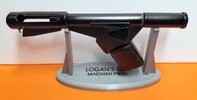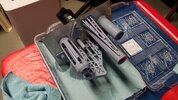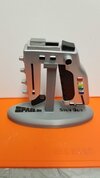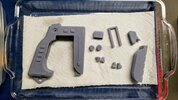A few printing artifacts I need to investigate like this rough spot…
Hey Sean-- looking at your calibration cube and the print, I see a few areas that I think I can help you hone in on--
1. The cube has "ghosting" on it--the you can see the X is patterned through the side of the cube. That is related to belt tightness, printing speed, acceleration, and jerk.
2. Your vertical corners of the cube are bulged out and create more prominent seams. You can see this on the benchies too-- at the corners of the cabin. Tuning your flow rate should help with this-- print a flow rate cube to test wall thickness accuracy, and explore the settings related to the ending of lines-- cant remember the name of it for the life of me-- might be "enable Coasting" in cura
3. looking at the bottom of the owl prints and the bottom of your cube, along with the other post where you have a pile of prints that came unstuck, it seems your bed leveling is off-- or at least too high. I've always had great success getting the level as close as possible, then micro stepping the z-offset down through the printers tuning menu. Not sure to what extent the Aquila supports that-- I think it is running a modified Marlin firmware so it should through the printing tuning menu.
4. The rough patch on the helmet looks to be under extrusion-- you can see this in the support structure as well it looks like. Calibrate your e-steps and this should help. I know on my printer, the ender 3 v2, the extruder uses a plastic extruder arm that always has to be replaced because it cracks. If the Aquila has a plastic arm, highly recommend replacing it-- its about $5 on amazon.
5. Lots of stringing on your helmet-- tune your retraction rate with a retraction tower test and you should be able to find the sweet spot. I print at 5.5mm retraction, but every printer is different depending on the exact length of the Bowden tube.
If you end up flipping to the smooth side of the bed, I like to use a light layer of purple glue stick on my glass bed. It gives you some grace with leveling, and you can print smaller details on the bed easier-- don't think I've ever had a build come undone using it. If you are having trouble getting the prints off after, just pop the plate in the freezer for a few minutes to let the glass contract a bit and the print should pop right off.
Lastly, when printing helmets, most people can print them with no support on the inside and not have any trouble. The inside will have strings, but the top will look perfect. Should cut off a ton of time and save you a bunch of filament. You can also flip it upside down and support it on the top of the dome, but that will require a lot of sanding and filling.
Good luck! If you run through teaching tech's calibration files that should address most/all of those issues, but hopefully this helps you get at the specific problems more quickly!






